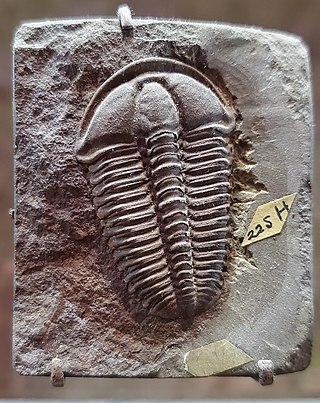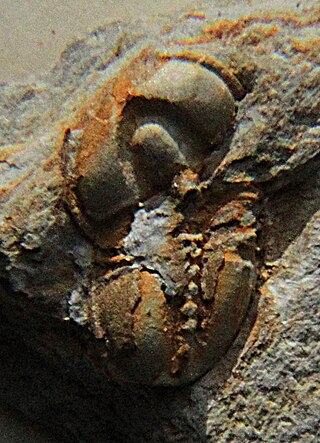
Phacopidae is a family of phacopid trilobites that ranges from the Lower Ordovician to the Upper Devonian, with representatives in all paleocontinents.

Dalmanites is a genus of trilobite in the order Phacopida. They lived from the Late Ordovician to Middle Devonian.

Paradoxides is a genus of large to very large trilobite found throughout the world during the Middle Cambrian period. One record-breaking specimen of Paradoxides davidis, described by John William Salter in 1863, is 37 cm (15 in). The cephalon was semicircular with free cheeks ending in long, narrow, recurved spines. Eyes were crescent shaped providing an almost 360° view, but only in the horizontal plane. Its elongate thorax was composed of 19–21 segments and adorned with longish, recurved pleural spines. Its pygidium was comparatively small. Paradoxides is a characteristic Middle-Cambrian trilobite of the 'Atlantic' (Avalonian) fauna. Avalonian rocks were deposited near a small continent called Avalonia in the Paleozoic Iapetus Ocean. Avalonian beds are now in a narrow strip along the East Coast of North America, and in Europe.

Zeliszkella is a genus of trilobite in the order Phacopida, with species of average size. Species are known from the Middle and Upper Ordovician and have been found in the Czech Republic, France, Morocco, Portugal and Spain.

Olenoides was a trilobite from the Cambrian period. Its fossils are found well-preserved in the Burgess Shale in Canada. It grew up to 10 cm long.

Dikelocephalus is a genus of very large trilobites of up to 50 cm (20 in) long, that lived during the last 3 million years of the Cambrian (Sunwaptan). Their fossils are commonly found as disarticulated sclerites, in the upper Mississippi Valley and in Canada (Alberta). The exoskeleton is rounded anteriorly, with the thorax and sides of the tailshield slightly tapering to about 2⁄3× of the width across the base of the spines at the back of the headshield. At the side corners of the pygidium there may be triangular or hooked spines, pointing backwards, while between the spines the posterior margin is at a 30-75° angle with the lateral margin, gently convex or nearly straight. If pygidial spines are lacking, the margin is gradually rounded. The thorax has 12 segments.

Meteoraspis is an extinct genus of ptychopariid trilobites of the family Tricrepicephalidae. The various species lived from 501 to 497 million years ago during the Dresbachian faunal stage of the late Cambrian Period. Fossils of Meteoraspis are characteristic of Late Cambrian strata in North America, though they are found in Late Cambrian strata elsewhere in the world, such as M. nevensis from Victoria Land, Antarctica.

Alokistocaridae is a family of ptychopariid trilobites that lived from the Botomian epoch of the Early Cambrian until the Late Cambrian. Alokistocarids were particle feeders and left small furrows which are occasionally preserved. Their remains are found worldwide. Elrathia kingii, one of the most collected trilobites in the world, is a typical alokistocarid.

Biceratops is an extinct genus of olenelloid redlichiid trilobites, of average size, with the largest specimen 8 centimetres or 3.1 inches long, not including the huge pleural spines of the 3rd segment of the thorax. It lived during the Toyonian stage, in what is today the South-Western United States. Biceratops can easily be distinguished from other members of Biceratopsidae by the absence of genal spines, in combination with effaced features of the raised axial area of the head shield, that is bordering the two horn-like projections that carry the eyes. Biceratops nevadensis is the only known species in this genus.

Ptychoparia is a genus of ptychopariid trilobites, and is the type genus of the family Ptychopariidae, and the order Ptychopariida.

Conocoryphe is a genus of primarily eyeless trilobites belonging to the family Conocoryphidae. They lived during the Middle Cambrian period, about 505 million years ago. These arthropods lived on the sea bottom (epifaunal) and lived off dead particulate organic matter.

Eodiscina is trilobite suborder. The Eodiscina first developed near the end of the Lower Cambrian period and became extinct at the end of the Middle Cambrian. Species are tiny to small, and have a thorax of two or three segments. Eodiscina includes six families classified under one superfamily, Eodiscoidea.

Ogygiocarella Brongniart, 1822, is a genus of asaphid trilobites. It occurred during the Middle Ordovician.

Geragnostus is a genus of very small agnostid trilobites whose fossils are found Ordovician-aged marine strata from Eurasia, North America and Argentina.

Pricyclopyge is a genus of trilobites assigned to the family Cyclopygidae that occurs throughout the Ordovician. Pricyclopyge had an extratropical distribution, and there is evidence that it lived in darker parts of the water column. Pricyclopyge has huge eyes, an inverted pear-shaped glabella, six thorax segments, with on the 3rd two small discs. Pricyclopyge is known from what are today China, the Czech Republic, France, and the United Kingdom.

Pliomera is a genus of trilobites that lived during the Middle Ordovician on the paleocontinent Baltica, now Norway, Sweden, Estonia and the Russian Federation, and in Argentina. It can be recognized for its pentagonal glabella widest between the frontal corners, with an inverted V-shaped occipital ring. In front of the occipital furrow that crosses the entire glabella, two pairs of dead-ending furrows create three side lobes left and right. The front of the glabella also has three dead-ending furrows, a very short one on the midline and left and right a longer one, directed inward and slightly backward. The eyes are small and are not connected to the glabella by an eye ridge. The thorax and pygidium are very regularly divided into up to 23 rather narrow segments, without a furrow within each of the pleurae. The pleurae are clearly wider than the axis. The pygidium ends in downward pointing toothlike spines.
Schmalenseeia is genus of trilobites of uncertain affinity, that lived during the middle Middle to earliest Upper Cambrian. Species assigned to Schmalenseeia have been found in Norway, Sweden, Northern Siberia, Eastern China, Australia (Tasmania), India (Himalayas) and the United Kingdom.

Tricrepicephalus is an extinct genus of ptychopariid trilobites of the family Tricrepicephalidae with species of average size. Its species lived from 501 to 497 million years ago during the Dresbachian faunal stage of the late Cambrian Period. Fossils of Tricrepicephalus are widespread in Late Cambrian deposits in North America, but is also known from one location in South America. Tricrepicephalus has an inverted egg-shaped exoskeleton, with three characteristic pits in the fold that parallels the margin of the headshield just in front of the central raised area. The articulating middle part of the body has 12 segments and the tailshield carries two long, tubular, curved pygidial spines that are reminiscent of earwig's pincers that rise backwards from the plain of the body at approximately 30°.

Telephinidae is a family of pelagic trilobites with large wide-angle eyes, occupying most of the free cheeks, downward directed facial spines and 9-10 thorax segments. The family is known during the entire Ordovician and occurred in deep water around the globe.

Viaphacops is a genus of trilobites in the order Phacopida, family Phacopidae, that lived during the Middle Devonian, and is known from North and South America, Asia.



















